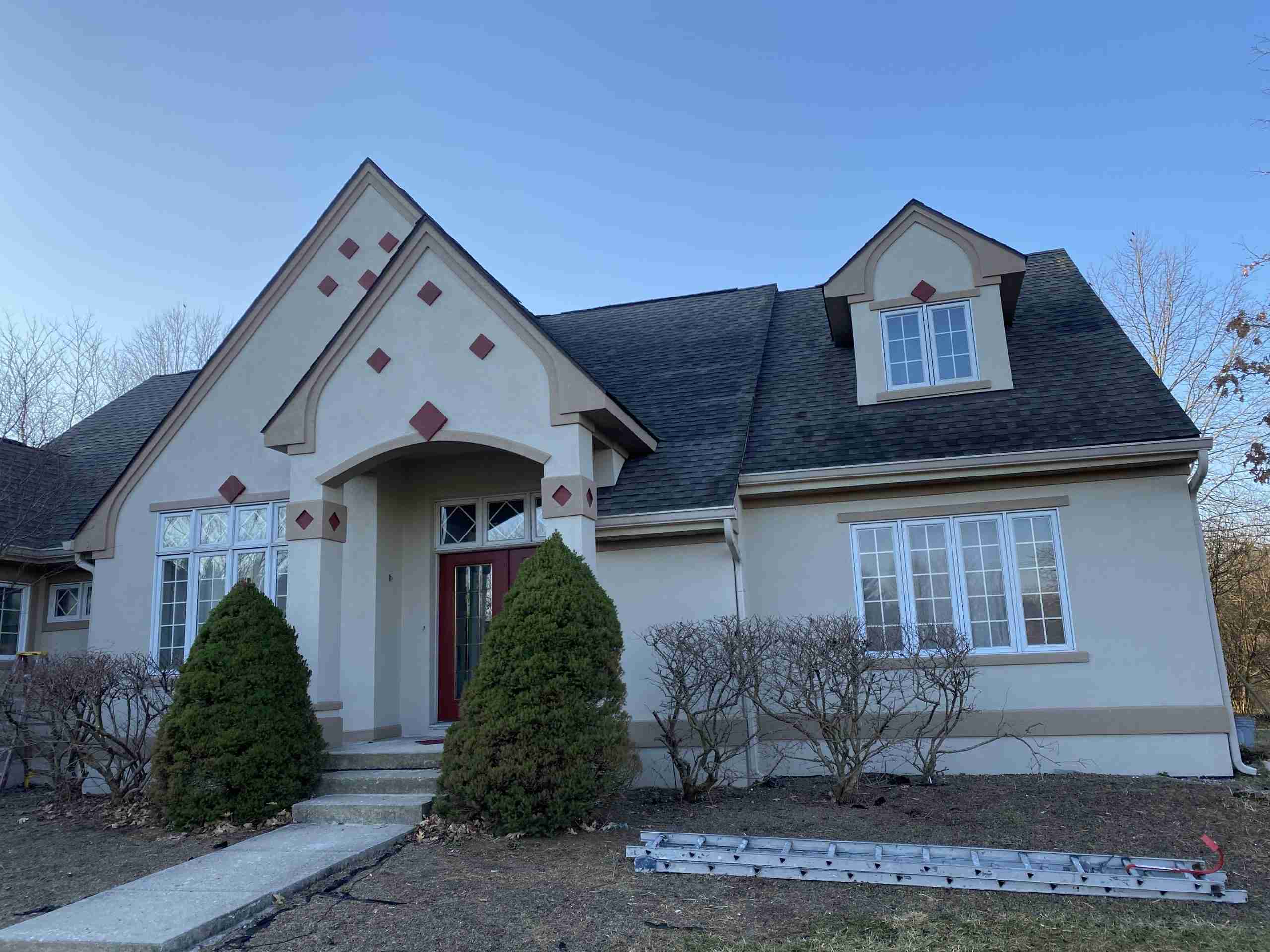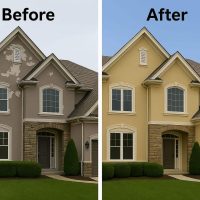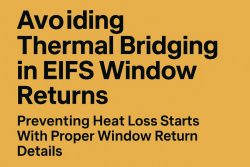Assessing the Best Approach for Revitalizing Your Older Exterior Insulation and Finish Systems
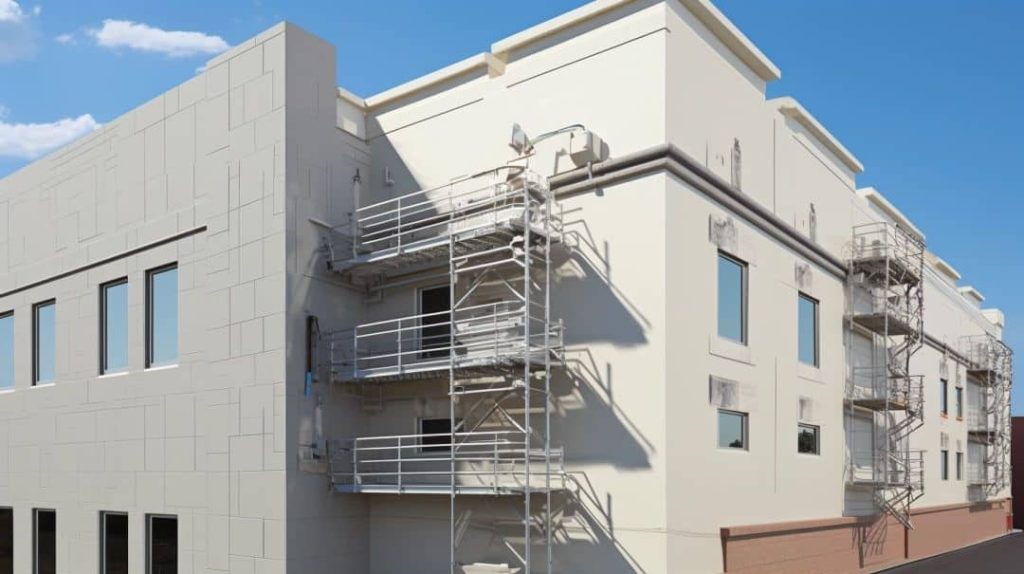
Exterior Insulation and Finish Systems (EIFS) have long served as a stalwart defender against the elements, enveloping buildings in an energy-efficient, water-resistant shell. However, as these systems age, they can succumb to wear and tear—posing challenges for property owners aiming to maintain both functionality and curb appeal.
With more than two decades of experience in building envelope solutions, I bring a deep understanding of EIFS’s complexities—ready to dispel myths about “quick fixes” and address the truth about restoration versus replacement.
Making informed decisions about older EIFS is critical; whether you opt for minor repairs or comprehensive upgrades can significantly impact your building’s longevity and value. Restoring your EIFS not only enhances its resistance to weather but also revitalizes its appearance—a key factor in preserving property value.
Read on to delve into strategies tailored for every level of EIFS restoration needs, empowering you with knowledge that leads beyond mere aesthetics to lasting protection. Let’s uncover the potential beneath your building’s surface.
Key Takeaways
- EIFS are important for energy efficiency and water resistance but can develop issues like cracking or moisture infiltration as they age. Regular maintenance and timely repairs can keep the system functioning properly and preserve building integrity.
- There are various restoration levels for older EIFS, ranging from simple cleaning and recoating to more involved processes such as overcladding or complete removal and replacement. The choice depends on damage severity, budget, and the building’s condition.
- Upgrading your EIFS not only improves its appearance but also increases weather resistance and insulation properties. Newer materials used in replacements meet current standards for performance, ensuring long-term savings on energy costs.
- Working with experienced contractors is essential when restoring EIFS to ensure quality workmanship. Properly maintained or restored EIFS extends a building’s lifespan while enhancing curb appeal and property value.
Understanding EIFS and Its Purpose
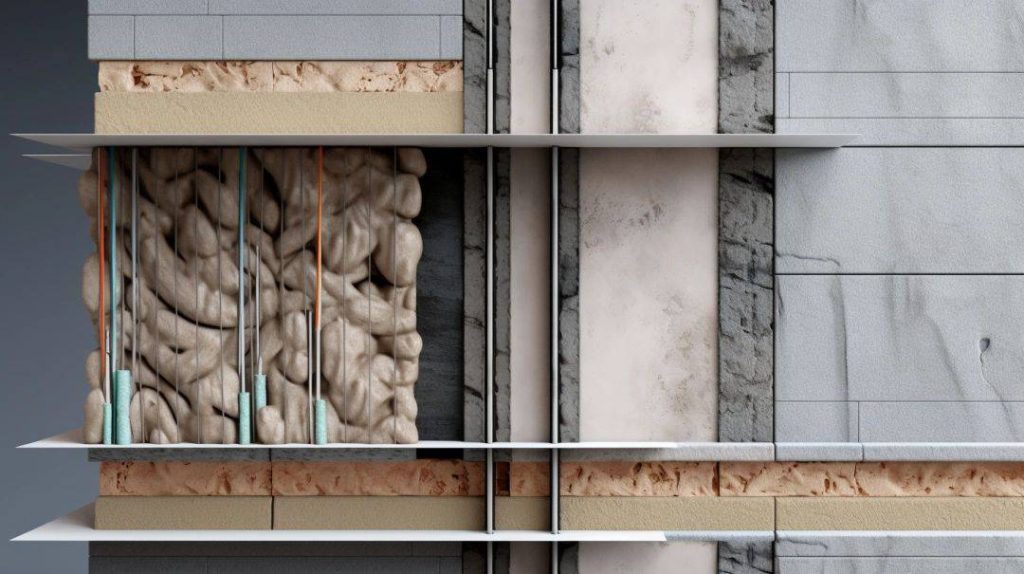
Exterior Insulation and Finish Systems (EIFS) serve a critical role in building design, offering superior energy efficiency and water resistance to protect structures from weather extremes.
However, older EIFS may exhibit common issues such as cracking or moisture infiltration, necessitating informed decisions on maintenance or renewal to preserve the integrity of the building envelope.
Energy-efficient and water-resistant properties
Energy efficiency is a key advantage of using EIFS on buildings. The system offers superior insulation, helping to reduce heating and cooling costs year-round. Its layers work together to keep the interior temperature steady, slashing energy bills significantly.
Not only does this contribute to lower operational expenses for building owners, but it also aligns with sustainable building practices that benefit the environment.
Water resistance is another hallmark of well-maintained EIFS. The materials used can effectively repel water when properly sealed, preventing moisture from seeping into walls. This is crucial for avoiding mold growth and structural damage caused by water infiltration.
Regular maintenance ensures the sealing remains intact, preserving these protective properties and extending the lifespan of the building’s exterior finish system.
Common issues with older EIFS
While EIFS systems are designed to provide excellent insulation and water resistance, older installations can face a host of problems. Moisture intrusion is one of the biggest culprits that leads to damage in these systems.
Over time, water can find its way behind the EIFS through cracks or improper sealing around windows and doors. This moisture build-up can result in mold growth, rotting of underlying materials, and a decrease in thermal efficiency.
Another frequent issue with aging EIFS is delamination, where layers start separating from each other or from the building substrate due to adhesive failure or impact damage. Cracking and fading of the finish coat are also common as the system weathers and ages.
These issues not only compromise the aesthetic appeal but can also affect structural integrity if left unaddressed. Regular inspection becomes crucial for early detection and intervention to maintain both performance and appearance over time.
Levels of Restoration for Older EIFS
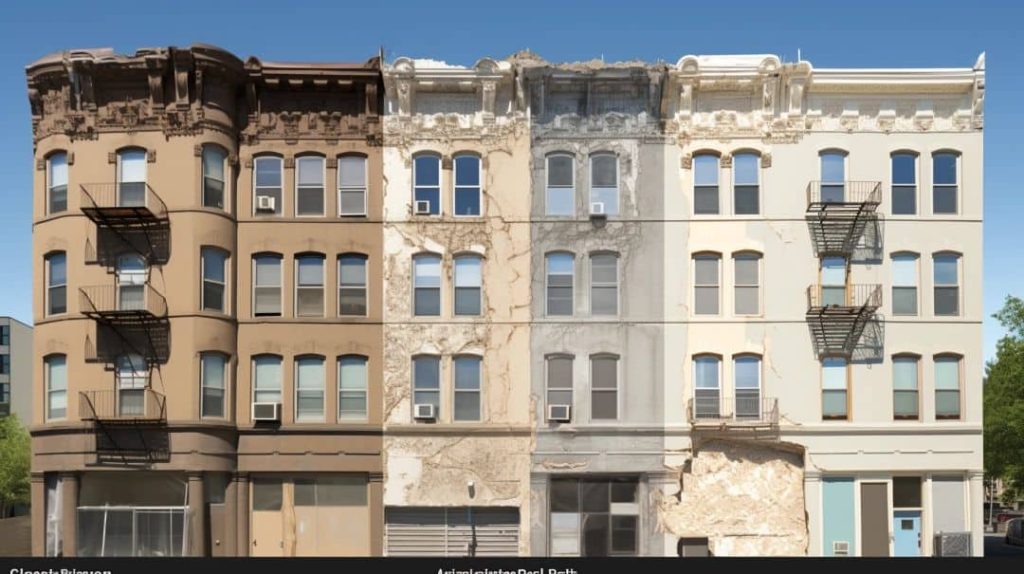
The restoration of older Exterior Insulation and Finish Systems (EIFS) can be approached through various methods, depending on the current condition and needs of the building. The levels range from a basic clean and recoat for minor aesthetic touch-ups to more comprehensive overcladding, which involves adding a new layer of protection to existing EIFS.
In cases where damage is extensive or if the system is outdated, complete removal and replacement might be necessary to ensure both aesthetic appeal and structural integrity. Each level offers different benefits and requires careful consideration of factors such as cost, longevity, and performance enhancements to determine which method will best restore the building’s exterior cladding to its optimal state.
Clean and recoat
Keeping your building’s exterior fresh and appealing can be as straightforward as a clean and recoat process. This level of EIFS restoration involves removing unsightly dirt, mold, or mildew that accumulates over time, giving your property a refreshed look.
It’s not only about aesthetics; this maintenance step also plays a significant role in protecting the facade from elemental damage by applying a new protective coating.
For building owners looking to update their property’s color or simply revitalize the existing finish, recoating is an efficient solution. Generally less costly than other restoration methods, it extends the life of your EIFS by providing an additional layer against weathering and wear.
Engage in regular cleaning and apply high-quality coatings to ensure your investment remains robust and attractive for years to come.
Repair and refinish
After addressing minor wear and tear through cleaning and recoating, the next step is to tackle more substantial issues with repair and refinishing. This process involves fixing any cracks or dents in your EIFS to prevent water intrusion, which can lead to more severe structural problems if left unaddressed.
Skilled contractors will fill these imperfections with a special patching compound designed for EIFS before applying new finish coats that blend seamlessly with the existing surface.
This not only restores the aesthetic appeal of your building but also reinforces its protective layer against environmental damage.
Restoration doesn’t stop at mere appearance; it extends to fortifying your investment against future issues. Refinishing includes selecting durable coatings that match the current façade while providing additional defense from harsh weather conditions.
These advanced sealants are specifically formulated to adhere well to older EIFS surfaces, ensuring longevity and resistance against UV rays and moisture penetration—essential factors for maintaining a robust building envelope.
By repairing and refinishing proactively, you safeguard both the look and integrity of your property without a full-scale replacement.
Overclad
Moving on from repairs and refinishing, overclad presents a robust solution for building owners looking to upgrade their EIFS facade without complete removal. By applying a new layer of cladding over the existing system, property owners can achieve an updated look and enhanced protection against the elements.
This method is often more cost-effective than a full replacement and serves as a practical approach to extend the life of your building’s exterior.
Opting for an overclad does not only refresh the aesthetic appeal but also adds another line of defense against weather-related wear and tear. It allows you to incorporate newer, superior materials that offer better insulation and durability while keeping disruption to your business at a minimum.
With careful planning and execution by experienced contractors, overcladding swiftly improves both the performance and curb appeal of aged structures in need of revitalization.
Remove and replace
Sometimes an EIFS facade reaches a point where repairs just won’t cut it. That’s when removing and replacing becomes the necessary route for building owners to take. It’s a comprehensive solution that addresses extensive damage, preventing future issues from arising.
This process involves stripping away the old system, ensuring no underlying structural problems are hidden beneath, and installing fresh, new EIFS cladding. It rejuvenates the building’s appearance and promises added longevity.
Choosing to remove and replace offers more than a visual upgrade; it can also enhance insulation properties, thereby improving energy efficiency across your property. The new installation brings with it updated materials and techniques that align with current building codes and standards – making this option not only about aesthetics but also about compliance and performance optimization for years to come.
Factors to Consider in Determining the Best Approach
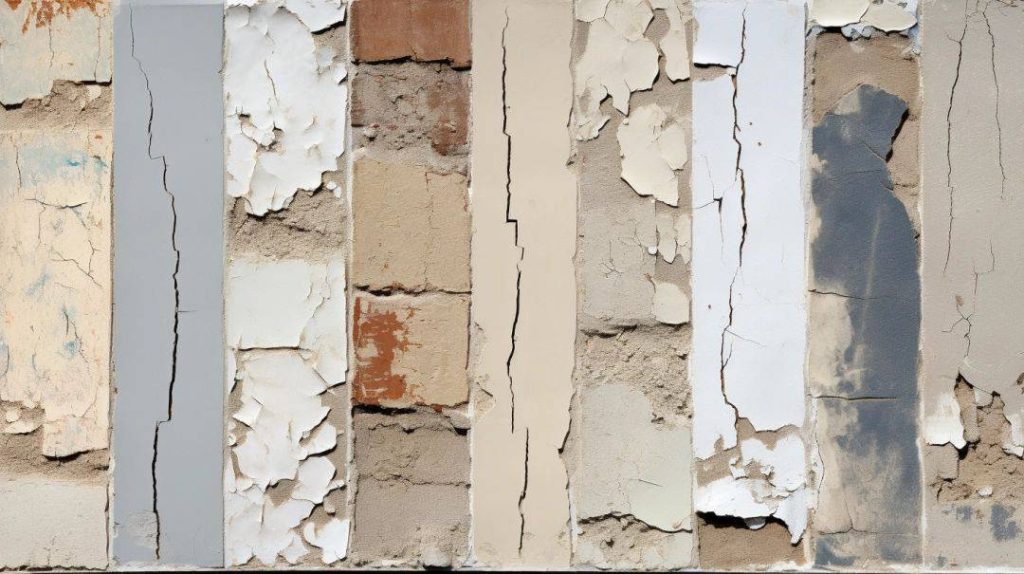
Assessing an older EIFS involves careful consideration of damage severity, financial constraints, the structural integrity of your building, and aesthetic aspirations—all crucial in deciding whether to remove, repair, or upgrade.
Explore your options further to make an informed decision that aligns with your preservation goals.
Extent of damage
Evaluating the extent of damage on your building’s EIFS is a crucial first step before deciding on repair or replacement. Signs of wear might range from hairline cracks to extensive water infiltration causing major structural issues.
Simple repairs can address small blemishes and prevent them from escalating into larger problems, maintaining the integrity of your property’s exterior insulation and finish system.
As a building owner, look for symptoms such as bulging, discoloration, or soft spots in the cladding which suggest deeper trouble. These concerns necessitate comprehensive restoration efforts that could involve retrofitting parts of the façade or even full-scale removal and reinstallation.
The condition of your EIFS not only affects property value but also plays a vital role in energy efficiency and weatherproofing. It’s essential to catch these problems early to avoid costly interventions later on, ensuring the health and longevity of your investment.
Cost and budget
Understanding the extent of damage to your EIFS is crucial, but it’s equally important to align restoration decisions with your financial capabilities. Tackling such projects requires a careful examination of costs and setting a realistic budget.
Full-scale replacement might be necessary for severe cases, but this option can strain budgets if not planned for accordingly. Fortunately, repair and refinish solutions offer more affordability and can prevent minor issues from escalating into costly repairs down the line.
Choosing the right level of intervention is key to managing expenses without compromising on quality. Overclad methods have been shown as cost-effective alternatives that refresh the building’s appearance while providing additional insulation benefits.
Keep in mind, that regular maintenance after restoration can help avoid future high expenses by sustaining the health and longevity of your EIFS-clad building envelope; invest wisely now to save later.
Building’s condition and age
Considering your budget is crucial, but the building’s condition and age are equally vital to making an informed decision on whether to remove, replace, repair, resurface or upgrade your EIFS.
A newer building might only need minor repairs or a fresh recoat to protect its exterior insulation and finish system. However, older structures may show signs of significant wear or structural issues that call for a more comprehensive approach.
Evaluate the age of your property and the current state of its cladding carefully. Older EIFS systems may have outdated materials that no longer meet modern standards for energy efficiency or weather resistance.
If you’re facing extensive damage due to long-term exposure or previous neglect, a full replacement could be necessary to restore not just aesthetics but also integrity and performance.
This investment can significantly enhance durability while improving thermal properties—leading ultimately to increased property value and cost savings on future maintenance.
Desired aesthetic
Choosing the right restoration approach for your EIFS can dramatically influence the look and feel of your building. If you want to refresh the facade’s color or update its appearance, recoating might be sufficient.
For a more comprehensive makeover that addresses both function and form, consider overcladding or full replacement to give your property a modern edge while ensuring longevity.
Tailoring the renovation to meet aesthetic preferences without compromising on quality demands attention to detail. An exterior that mirrors current trends or aligns with traditional design principles can breathe new life into an older building.
By selecting textures, colors, and finishes that resonate with your vision, you’ll not only enhance curb appeal but also potentially increase property value through improved visual impact.
Sealant Replacement and Maintenance
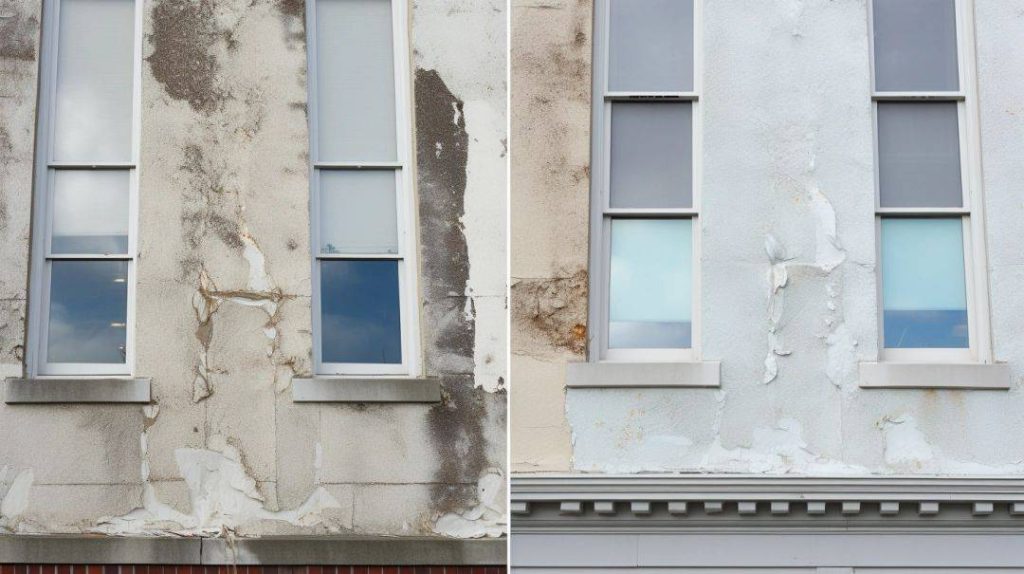
Regular maintenance and the correct application of sealant are pivotal in safeguarding older EIFS against moisture intrusion and prolonging their lifespan; employing proper techniques for sealant replacement not only prevents potential structural issues but also ensures continued energy efficiency and aesthetic appeal.
Importance of regular maintenance
Regular maintenance on your building’s EIFS cladding is essential for preserving the system’s integrity and aesthetic appeal. Ignoring small issues like cracks or separations in sealant can lead to water infiltration, with the potential for greater structural damage down the line.
Maintenance involves inspecting sealants and addressing any damage promptly to keep moisture out and energy costs down. It ensures that minor repairs don’t escalate into major expenses.
Effective maintenance includes replacing the old backer rod and mechanically removing the failing sealant before applying new caulking as needed. This proactive approach helps maintain your building’s exterior insulation system, thereby sustaining its appearance, performance, and durability over time.
Maintaining a healthy building envelope also maximizes property value—a clear benefit for any building owner looking to protect their investment.
Next up in this guide: Proper techniques for sealant replacement—another key aspect of maintaining an efficient and attractive EIFS facade.
Proper techniques for sealant replacement
Replacing the sealant in your EIFS is a critical step in maintaining your building’s exterior. It ensures that your property stays water-resistant and visually appealing. Here are the proper techniques for sealant replacement:
- Inspect the EIFS thoroughly to locate all the areas where the sealant needs replacement. Pay special attention to corners and joints where water can easily penetrate.
- Clear out any old, failing sealant using specialized tools designed for sealant removal, such as a razor knife or sealant cutout tool.
- Prepare the surface by cleaning it well; remove dust, debris, or residue from the old material so that new sealant will adhere properly.
- Apply a primer if recommended by your sealant manufacturer; this can enhance adhesion and ensure long-term performance.
- Select an appropriate high-quality sealant that matches your EIFS system’s requirements and provides strong weatherproofing protection.
- Cut the nozzle of the sealant tube at a 45-degree angle to match the joint width for consistent application and avoid overfilling.
- Use a caulking gun to apply the new sealant steadily along each seam, filling it completely from one end to another without leaving gaps or air pockets.
- Tool the applied sealant with a spatula or caulking tool to press it firmly into place and create a smooth, clean finish that sheds water effectively.
- Check all treated areas for missed spots or imperfections before allowing them to dry according to manufacturer specifications.
Selecting the Right Contractor

Selecting the right contractor is a pivotal step in ensuring that your EIFS restoration meets both quality standards and project expectations. Look for professionals with specialized experience in EIFS systems, proven track records backed by client references, and all necessary licensing and insurance to protect your investment during the renovation process.
Experience and expertise
Choosing the right contractor for your EIFS project is not just about finding someone who can apply a new finish or patch up some cracks. It’s about securing an expert with a deep understanding of how exterior insulation and finish systems work – from installation to long-term maintenance.
An experienced contractor brings invaluable knowledge of materials and techniques that have been proven effective over time. They’ll recognize signs of wear that others might miss, ensuring minor issues don’t escalate into major ones.
The expertise of your contractor directly impacts the health and longevity of your building’s envelope. A skilled professional stays updated with the latest industry standards, using cutting-edge solutions for insulation upgrades or enhanced durability with reinforced mesh options.
Their proficiency in replacing old backer rod correctly or removing existing sealant through mechanical abrasion means higher quality restoration work—a crucial investment in preserving your property’s value and structural integrity.
Reputation and references
Having established the importance of a contractor’s experience and expertise, it’s critical to consider their reputation and references as well. Ask for contact information of previous clients who have had similar EIFS restoration work done on their properties.
Positive feedback from other building owners can be a strong indicator that the contractor delivers quality craftsmanship and reliable service. Check online reviews as well—to see what others are saying about their timeliness, professionalism, and how they handle any issues that arise during a project.
A good standing in the industry often reflects a history of successful projects and satisfied customers. Delve into references to gauge whether past clients experienced enhanced building aesthetics or improved energy efficiency after upgrading older EIFS systems with that contractor.
This step ensures you’re entrusting your property’s exterior renovation to someone whose track record proves they can execute complex restorations while maximizing the health and longevity of your building envelope.
Licensing and insurance
Selecting the right contractor goes beyond verifying their experience and reputation; it’s crucial to check their licensing and insurance as well. Licensed contractors have met industry standards and local regulations, ensuring they’re qualified to handle your EIFS restoration project professionally.
Their insurance, meanwhile, protects you from being liable for any accidents or damages that may occur on-site during the renovation process.
Furthermore, make sure the contractor carries liability insurance and workers’ compensation coverage to defend against potential financial risks associated with construction work. This layer of security gives peace of mind knowing you’re choosing a reliable professional who takes responsibility for their team’s safety and the integrity of your building project.
Moving forward, consider modern solutions that can enhance older EIFS systems for better performance and aesthetics.
Modern Solutions for Older EIFS
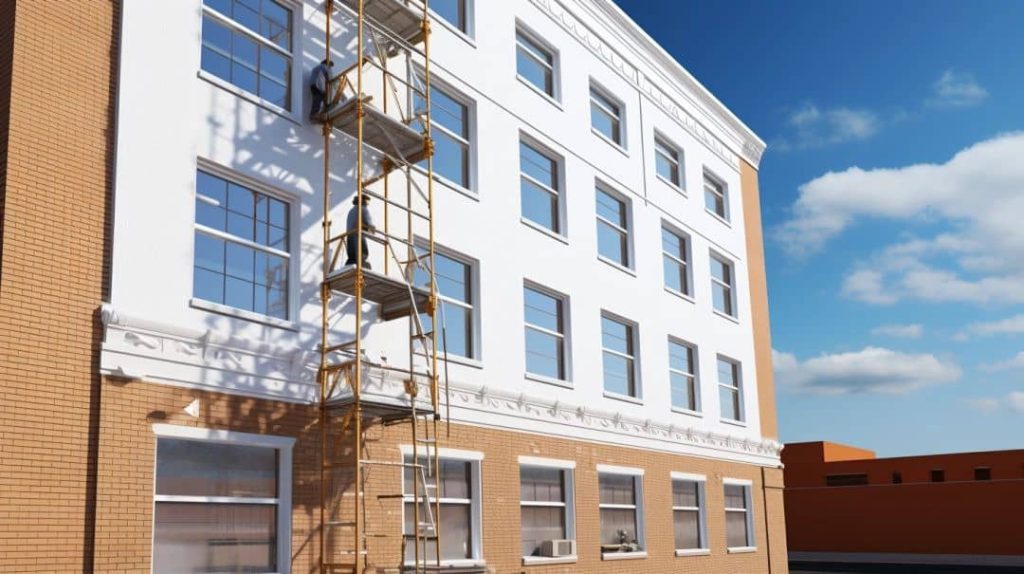
Discover cutting-edge advancements in sealants and insulation that rejuvenate aging EIFS, providing your building not only with a fresh facade but also enhanced energy efficiency and strength—dive into these innovations to propel your property’s performance into the future.
Advanced sealant and coating options
Advanced sealant and coating options for older EIFS systems bring both aesthetic and practical benefits. High-performance sealants not only add to the curb appeal with a fresh finish but also provide an impenetrable barrier against moisture and environmental damage.
These modern formulations are designed to flex with your building, accommodating movement without cracking or losing adherence. Protective coatings now come with added features such as resistance to fading, mold, mildew growth, and even self-cleaning properties.
Innovations in this field have transformed traditional EIFS into robust cladding solutions that stand up better over time. They extend the life of your facade while reducing maintenance needs, ensuring your investment is well-protected for years to come.
Looking beyond aesthetics, these advancements contribute significantly to energy conservation by enhancing the insulative properties of the exterior envelope. The next topic will explore how improved insulation upgrades can further boost energy efficiency for property owners.
Improved energy efficiency through insulation upgrades
Building on the foundation of enhanced sealant and coating options, insulation upgrades play a pivotal role in modernizing older EIFS. Upgrading to high-performance insulation materials not only fortifies your building against the elements but also significantly boosts energy efficiency.
These improvements help maintain optimal temperatures within, reducing reliance on heating and cooling systems and leading to noticeable savings on energy bills.
Investing in superior insulation is more than just cutting costs; it’s about embracing sustainability for long-term benefits. High-quality insulation contributes to a tighter building envelope, ensuring temperature consistency and comfort year-round.
For owners looking at an EIFS retrofit or renovation, prioritizing insulation updates can dramatically enhance your property’s performance while contributing positively toward environmental conservation efforts.
Enhanced durability with reinforced mesh
Taking EIFS durability to the next level, reinforced mesh plays a pivotal role in extending the lifespan of your building’s exterior. This robust material is intricately woven into the layers of EIFS, providing much-needed support and resistance against cracks or structural wear from daily exposure to elements like wind and rain.
Reinforced mesh acts as a shield, fortifying vulnerable points and ensuring that minor impacts don’t escalate into costly repairs.
Incorporating reinforced mesh during an upgrade not only bolsters your building’s defenses but also contributes to its overall sturdiness. It reinforces critical stress areas, such as corners and edges where damage is most likely to occur.
With these enhancements, property owners can enjoy peace of mind knowing their investment is safeguarded against the rough treatments of time and nature—maintaining both aesthetic appeal and structural integrity for years to come.
Benefits of Fully Upgrading and Restoring Older EIFS
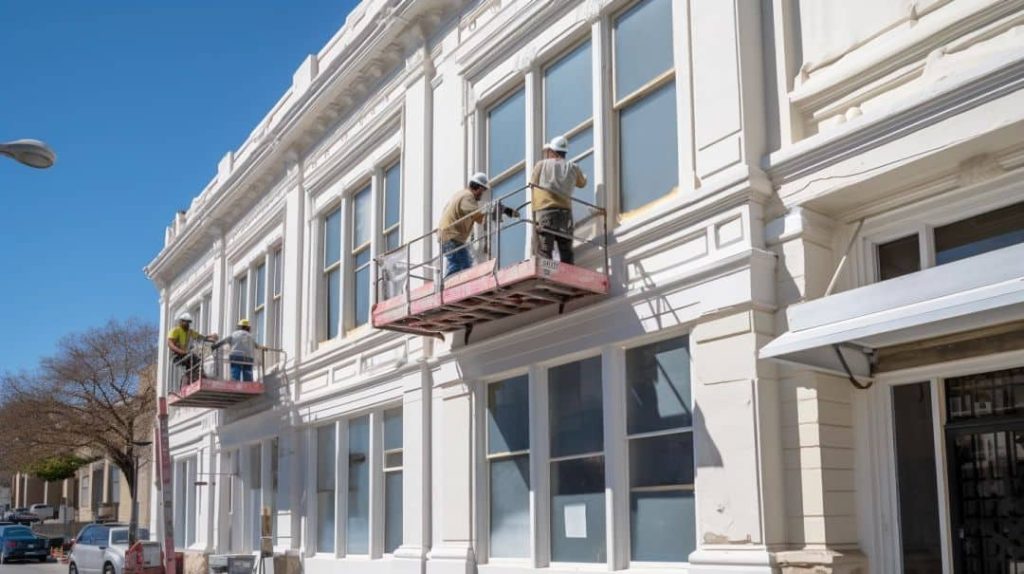
Fully upgrading and restoring older EIFS offers significant advantages, including enhanced energy efficiency that leads to substantial cost savings over time. This process can transform the look of a building, providing it with an updated aesthetic that could increase its curb appeal and overall market value.
Upgraded systems use advanced materials such as reinforced mesh for greater durability, ensuring the exterior remains robust against environmental stressors. With these improvements, property owners not only preserve but also potentially elevate their investment.
Improved energy efficiency and cost savings
Upgrading older EIFS systems can lead to significant energy savings for building owners. The latest advancements in insulation materials enhance the thermal resistance of your building’s envelope, cutting down on heating and cooling costs throughout the year.
This means that not only does your building maintain a more consistent temperature, but you also reduce your carbon footprint and save money on energy bills.
Optimizing an EIFS system streamlines energy consumption by addressing drafts and air leaks where heat or cool air might escape. With restoration techniques like sealing and proper installation of enhanced insulation products, buildings become more energy-efficient than ever before.
Investing in these upgrades pays off quickly as operational expenses decrease over time—a smart economic move for any property owner looking to manage long-term costs effectively.
As we turn our attention to enhancing the aesthetic appeal of a renovated facade, remember that improved efficiency is just one piece of the puzzle leading to increased property value.
Enhanced building aesthetics
The right EIFS restoration can transform your building’s appearance, giving it a fresh and modern look. A newly coated or refinished exterior not only stands out but also speaks volumes about the value you place on your property.
Consider how an updated color scheme or a sleek new finish could revitalize your building’s presence in the neighborhood. With options ranging from simple recoating to complete replacement, enhancing your building’s aesthetics might be more straightforward than you think.
Improved curb appeal can lead to increased property value—a significant advantage for any building owner. Choose a restoration process that aligns with your vision and watch as passers-by admire the renewed vibrancy of your space.
Next, let’s delve into how this upgraded exterior contributes to heightened property values, setting the stage for our discussion on “Increased property value.”.
Increased property value
Upgrading and restoring older EIFS boosts your building’s market value significantly. A refreshed exterior not only attracts attention but signals to potential buyers or tenants that the property is well-maintained and modernized.
Investing in EIFS restoration can prevent minor cosmetic damage from evolving into costly structural repairs, safeguarding both the building’s integrity and its financial worth.
Proper maintenance and a restored facade reflect the owner’s commitment to quality, which can tip the scales in real estate assessments. This enhanced curb appeal translates directly to increased property values, making it an investment that pays off in both aesthetics and economics.
Next up, we’ll explore Sto’s A.R.T. of reStore® Program and how it can benefit your building envelope.
The Comprehensive Approach of Sto’s A. R. T.
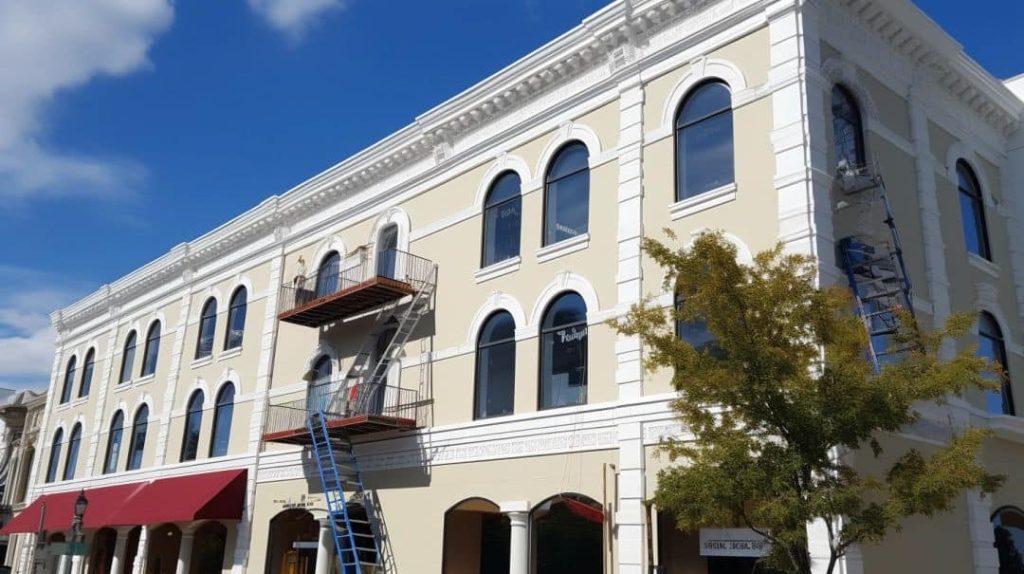
The Sto’s A.R.T. of reStore® program delivers a multi-tiered EIFS restoration strategy, offering building owners tailored solutions that range from basic preservation to full-scale reconstruction, emphasizing the essential role of maintaining a structure’s integrity and aesthetic appeal over time.
Four levels of restoration: preservation, rehabilitation, restoration, and reconstruction
Restoring your building’s EIFS is a key step in maintaining its value and structural integrity. Here are the four crucial levels of restoration that every building owner should consider:
- Preservation: This first stage involves regular upkeep to keep your EIFS looking fresh and functioning properly. It includes cleaning off dirt, mold, and mildew as well as recoating surfaces to renew the facade’s color. Routine maintenance such as sealing cracks or gaps with proper caulking prevents small issues from turning into big repairs.
- Rehabilitation: When minor damage has occurred, rehabilitation is necessary to fix it before it worsens. This level may consist of patching up small areas or addressing discoloration issues. Repairing these early signs of wear can extend the life of your EIFS and stave off more extensive damage.
- Restoration: Sometimes, a surface needs more than just a touch-up; it might require a full-fledged restoration. This process can involve removing old sealant through mechanical abrasion and replacing compromised materials to restore the EIFS to its original condition or better.
- Reconstruction: The most extensive level is reconstruction, which comes into play when an EIFS system requires complete removal and replacement. It’s chosen after assessing extensive damage or when a full upgrade is needed for energy efficiency improvements or aesthetic reasons. A new installation ensures your building envelope meets current standards in weatherproofing and insulation.
The importance of preserving and maintaining a building’s health
Tackling the four levels of restoration can lead to significant improvements in a building’s overall well-being. Just like regular check-ups for your own health, maintaining and preserving a structure ensures that minor issues don’t escalate into costly repairs.
A proactive approach not only keeps the building safe and functional but also reflects on its value and appeal. Fixing small problems before they become big ones prevents damage from spreading, which can save owners from heavy future expenses.
Preservation efforts extend the life of buildings, guarding against weather damage and wear over time. By updating sealants and caulks, property owners safeguard their investment by locking out moisture which could otherwise lead to mold growth or structural decay in EIFS systems.
Consistent maintenance is key; it guarantees that energy efficiency remains high while keeping utility costs low – boosting both performance and savings. Protecting this outer shield directly impacts the longevity of any commercial or residential establishment, translating to preserved beauty, strength, and market worth.
Conclusion
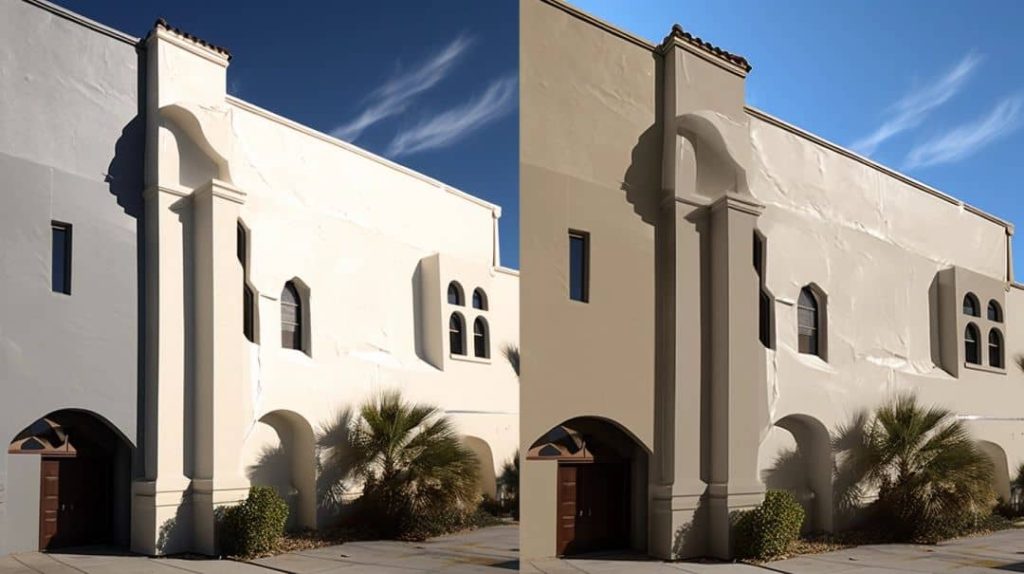
In the face of aging EIFS, building owners have a clear pathway: clean, repair, overclad or replace. Keeping your building in top shape means considering damage extent and costs while prioritizing regular maintenance.
Embrace modern solutions; they offer impressive benefits like enhanced aesthetics and energy efficiency for your property. Seek expert contractors who ensure quality workmanship, further safeguarding your investment.
Remember that taking action today secures not just a beautiful facade but also the enduring value of your property. Contact us for a free estimate or call (765) 341-6020 for more details!
FAQs
What are some common issues that arise with older EIFS systems?
Older EIFS often face problems like moisture intrusion behind the system leading to mold growth or rotting materials. Other common issues include delamination of layers, cracks in the finish coat, and fading. These problems affect appearance and can compromise structural integrity over time if unchecked.
What factors should I consider when deciding whether to repair, resurface, or replace my older EIFS?
Key factors include the severity of existing damage, your budget constraints, the current condition and age of the building, and your desired aesthetic for the facade. Assessing these elements helps determine the best approach – from minor repairs to full system replacement.
Does upgrading older EIFS provide any benefits beyond improving appearance?
Yes, upgrading EIFS boosts weather resistance and insulation properties compared to older materials. Newer replacement systems meet modern energy efficiency standards, ensuring long-term savings on energy bills. The upgrades also use advanced sealing methods to prevent moisture intrusion.
How often should I perform maintenance on my EIFS like re-caulking seals?
Industry experts recommend inspecting EIFS sealants at least once a year and re-caulking as needed. Proactive maintenance prevents minor cracks and gaps from turning into major pathways for water infiltration that could cause structural damage.
What qualifications should I look for when hiring an EIFS contractor?
Seeking contractors with specialized EIFS experience, strong references from previous clients, and proper licensing and insurance is advised. Their expertise and quality workmanship ensure the restoration meets aesthetic and performance goals while protecting your investment.

